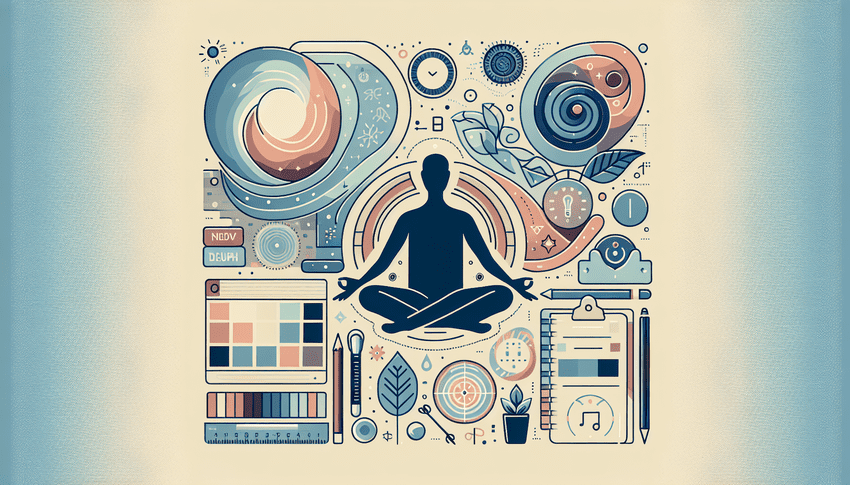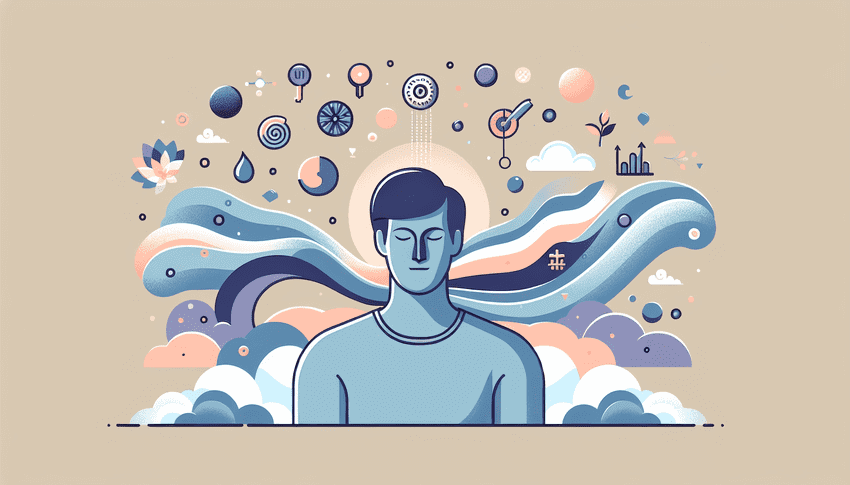Table of Contents
The Psychology of Flow

Defining Flow and its Psychological Underpinnings
Engagement, focus, and a profound sense of fulfillment—these are all components of what has been coined as the ‘Flow State.’ The term itself possesses a certain magnetism; it’s the mental zone where productivity peaks and creativity flows like a river.
Understanding the Psychological Mechanism of Flow In the realm of Positive Psychology, the Flow State is akin to the Holy Grail of mental states. Mihaly Csikszentmihalyi, who pioneered the study of flow, describes it as the mental state in which a person performing an activity is fully immersed in a feeling of energized focus, full involvement, and enjoyment. But what catalyzes this elusive state?
- Concentration is the bedrock of flow. When wholly absorbed in a task, distractions fade, and a person can experience a merging of action and awareness.
- Flow State is often achieved when there is a balance between the perceived challenges of a task and one’s perceived skills. It is at this intersection that individuals often find themselves operating with high degrees of both efficiency and satisfaction.
- Immediate feedback is integral to maintaining Flow State. When one’s actions are met with immediate and clear feedback, the path to improvement or redirection is crystal clear, which helps to sustain the state of flow.
The flow isn’t merely an abstract concept; it has tangible neurological correlates. During flow, the brain enters a state of transient hypofrontality, where the prefrontal cortex temporarily downsizes its activity. This implies a decrease in self-criticism and reflective consciousness, allowing for more streamlined and focused cognitive processing—a likely mechanism behind those periods of intense concentration and creativity.
To discern what the Flow State looks like in real-world situations, we may observe professional athletes performing with a grace that seems almost effortless, or artists who lose themselves in their art and produce work that resonates with profound depth. For instance, a marathon runner might hit a stride where each step is in perfect sync with their breath and the surrounding environment—a perfect encapsulation of flow. Similarly, a musician lost in improvisation is often in the throes of this powerful state, playing not just with instruments but with the very fabric of emotion and expression.
Achieving Flow State is not confined to the arts or sports; it’s accessible in everyday work and leisure. When a writer crafts a narrative or a programmer delves into code, they too can enter this zone, where time becomes immaterial, and the task at hand is all that exists.
By understanding the cognitive mechanics behind Flow State and recognizing the conditions that engender it, individuals are empowered to harness this focused energy in various aspects of their lives. The pursuit of Flow State is not just a journey towards optimal performance but also towards a richer, more contented experience of life’s endeavors.
Achieving Flow in Everyday Life
Achieving a state of Flow, the zone where productivity meets pleasure, is not a distant fantasy; it’s a tangible reality that can enrich our daily life when we understand how to tap into it. Flow State Happiness arises from tasks that engage us completely, requiring just the right balance between challenge and skill. To enter this state, one must set clear, achievable goals that provide direction and structure to the endeavor at hand.
One practical approach to finding Flow in our everyday routine is the harmonization of our tasks with our skill level. If something is too easy, we risk boredom; too hard, and we meet frustration. Achieving Flow necessitates a challenge that stretches our abilities without surpassing them. For example, a writer may choose a topic that is unfamiliar yet intriguing, pushing towards research and thoughtful writing without being overwhelming.
Creating an environment that nurtures concentration is another key element. This could mean arranging a workspace that minimizes distractions or setting aside specific times of the day for deep work. Imagine a programmer who, aware of her peak concentration times, schedules complex coding tasks during those windows and saves emails and meetings for periods of lower focus.
Overcoming Barriers to Flow
Even with clear goals and an optimal environment, barriers such as distractions and stress can impede our entry into Flow. To combat these obstacles, mindfulness techniques and prioritization strategies can be invaluable. We might consider the case of a teacher who uses mindfulness to stay focused amidst the chaos of a busy classroom, allowing him to engage deeply with each lesson.
Another method is to reframe challenges as opportunities for growth, thus transforming potential stressors into engaging puzzles. A graphic designer could view constructive feedback not as criticism but as a chance to refine their creative vision, thereby maintaining engagement and well-being. Immersive Activities Joy often emerges from such perspectives, where obstacles become part of the enjoyable journey of personal and professional development.
Flow Psychology isn’t just theory; it’s a robust, practical framework that can significantly enhance Engagement and Well-being. By setting clear goals, aligning challenges with skills, fostering a conducive environment, and overcoming barriers, Flow becomes an accessible state that brings Productive Happiness into our daily lives. Far from being confined to extraordinary circumstances, Flow is the art of transforming the ordinary into an extraordinary experience of immersed joy.
Emotional Intelligence and Happiness

Emotional Intelligence as a Predictor of Happiness
Emotional Intelligence, or EI, has been identified as a key factor in enhancing our subjective sense of happiness and well-being. Understanding and managing our emotions not only helps us to navigate the complexities of our own internal landscape but also aids immensely in relating to others.
The Connection Between EI and Happiness
Research has consistently shown a strong link between EI and happiness. Here’s why. Individuals with a heightened Emotional Intelligence are equipped with the tools to understand their emotions, which empowers them to manage stress and disruptions more effectively. They’re also better at interpreting and responding to the emotions of others, leading to more successful and satisfying relationships.
- Stress Management: People with high EI have refined coping strategies, allowing them to remain calm and composed under pressure. This contributes to less stress and more joy in their lives.
- Resilience: Emotional Intelligence fosters resilience, enabling individuals to bounce back swiftly from setbacks, an invaluable trait for long-term contentment.
- Social Connections: Those with stronger EI tend to forge deeper and more meaningful connections, which have been tied to greater happiness.
Flow State: The Optimal Experience of EI
Integrating EI into our everyday lives can often lead us into what is known as the Flow State, a term popularized by psychologist Mihaly Csikszentmihalyi. When individuals operate within a Flow State, they experience a sense of effortless action and deep immersion in their current activity.
- Flow and EI: Emotional Intelligence aids in recognizing the activities that trigger the Flow State, enhancing both performance and pleasure.
- Benefits of Flow: Individuals in a Flow State report higher levels of satisfaction and a strong sense of personal mastery, both of which are integral to happiness.
High EI fuels the ability to enter Flow States during various activities, whether in work, creative pursuits, or social interactions. By tapping into this seamless experience, we elevate not only our proficiency but also our overall happiness.
EI in Action: Practical Examples
Let’s consider an example: a teacher with advanced EI might use their skills to identify a student’s unspoken frustration, addressing it in a way that calms and empowers the student. This not only fosters a more positive classroom atmosphere but also enriches the teacher’s own sense of accomplishment, thus boosting their happiness.
In another scenario, a business leader with refined EI might navigate a high-stress negotiation by maintaining composure and empathy, leading to a satisfactory outcome for all parties involved. The leader’s ability to manage emotions contributes to personal and professional satisfaction.
In conclusion, Emotional Intelligence is more than just a psychological concept; it’s a practical tool for enhancing happiness. Through its application, individuals can navigate life’s challenges more gracefully, foster more meaningful relationships, and frequently enter the enriching state of Flow. As we continue to understand and harness the power of EI, we unlock the potential for a happier and more fulfilled life.
Building Emotional Intelligence for a Happier Life
Emotional Intelligence (EI) is a critical component in the journey to build a happier life. At the heart of EI lies the ability to recognize and manage your own emotions, as well as the emotions of others. Achieving Flow State, a profound sense of focus and engagement in activities, is invariably linked to heightened emotional awareness and regulation.
Understanding and Developing EI
The journey to bolstering Emotional Intelligence starts with self-awareness. To nurture EI, one must first understand the nuances of their feelings. Reflective practices like journaling and mindfulness can play a significant role in this endeavor. These techniques aid individuals in identifying patterns in their emotional responses and triggers, paving the way for better emotion management.
- Mindfulness, for instance, encourages one to be present in the moment, building awareness of one’s thoughts and feelings without judgment. This state of consciousness is akin to Flow State, where the mind is entirely absorbed in the present task or experience.
- Communication skills are also vital to EI, as they affect interpersonal relationships profoundly. Active listening and empathy are two key aspects that allow for a deeper understanding and connection with others, promoting harmonious interactions that contribute to personal happiness and well-being.
- Feedback, both giving and receiving, is another area within EI development. Constructive feedback helps individuals recognize their areas of strength and those needing improvement, framing these insights within the context of their impact on others.
Real-life examples of the impacts of improved EI are abundant. Imagine a stressful workplace where tensions often run high. An employee with strong Emotional Intelligence, who resides frequently in Flow State, would navigate these challenges calmly, offering conflict resolution skills that maintain peace and foster a supportive environment, ultimately enhancing productivity and satisfaction for the entire team.
Emotional Intelligence in Action
Consider a leader known for their transformational leadership style. This leader not only identifies with their own emotions but also empathizes with their team, recognizing their unique feelings and perspectives. Such leaders are often seen masterfully entering the Flow State, rallying their team around common goals, and leveraging the collective strength and emotional commitment of their team members to drive success.
In family life, a parent with high EI and the ability to access Flow State can better connect with their children. By understanding and reacting to their child’s emotions effectively, stressful situations like morning routines or homework battles become opportunities for teaching and bonding, rather than confrontation, leading to a more balanced and content family life.
In summary, increasing Emotional Intelligence is pivotal for achieving sustained happiness in life. Not only does it equip individuals with the skills to handle their internal emotional landscape, but it also enhances their relationships with others. By actively practicing mindfulness, honing communication skills, and seeking feedback, one can significantly improve EI. Embracing these strategies allows for more frequent experiences of Flow State, where the alignment of skills and challenge provides a profound sense of satisfaction and joy.
Summary
Imagine you’re on a tightrope, every muscle coordinated perfectly with the rhythm of the wind, your body’s balance, and the rope’s tension. There’s a singular focus that consumes your entire being—you are in the Flow State. The Flow State is where engagement, focus, and fulfillment intertwine, creating a sweet spot for productivity and creativity.
Decoding the Flow State Diving deep into the cognitive science behind Flow, one discovers that it’s a symphony of heightened concentration and a harmonious balance between challenge and skill. It’s here, in this exquisite equilibrium, that we often feel most alive and perform our best. Research pioneered by Mihaly Csikszentmihalyi pinpoints the key elements that usher us into this zone:
- Absorption: Total immersion is achieved when our focus narrows, and distractions become distant echoes.
- Challenge-Skill Balance: Flow emerges when we encounter tasks that stretch our abilities just right while aligning with our competencies.
- Immediate Feedback: This loop guides our actions, refines our approach, and solidifies our next moves, sustaining flow.
It’s not just an esoteric state; neurological studies suggest that during flow, the brain enters a phase of ‘transient hypofrontality,’ dialing down the prefrontal cortex. This neural downshift curbs the inner critic and allows for more concentrated cognitive processing.
Flow in Real Life From the gracefulness of an athlete in motion to an artist lost in brushwork, flow is palpable and powerful. For the marathon runner, it’s the harmony of breath and stride. For the improvising musician, it’s the seamless dialogue between soul and instrument. But flow isn’t limited to the arts or athletics. Professionals and hobbyists alike—from writers and programmers to gardeners and gamers—can also experience this phenomenon where moments extend and only the task at hand occupies the mind.
Understanding how to coax oneself into flow can revolutionize not just individual productivity, but also personal fulfillment in our day-to-day lives.
Integrating Flow into Everyday Life Creating a life filled with flow means fostering moments in the mundane to the magical. Here are a few ways to invite this state into your daily routine:
- Clarity of Goals: Understanding what you aim to achieve in any activity sharpens focus and directs engagement.
- Embrace Challenges: Opt for tasks just beyond your comfort zone to stay intrigued and invested.
- Minimize Interruptions: Craft an environment where concentration can thrive, free from distractions.
Flow and Emotional Intelligence (EI) Emotional Intelligence, with its prowess in handling stress and fostering social bonds, is also tied to flow. Those with high EI can more deftly navigate into flow, enriching both their performance and satisfaction. It is a blend of Inner peace and conscious action cascading into a harmonious lifestyle where happiness thrives.
Transforming daily tasks into deeply engaging experiences signifies the essence of flow. It turns routine into rhythm, ‘have to’ into ‘want to’, drastically enhancing life’s texture. Understanding and harnessing EI dovetails beautifully with flow, as both are instrumental in shaping a contented existence.
Incorporating EI can look like a leader using empathy to unify a team, a teacher connecting with students beyond words, or a parent transforming a child’s tantrum into a teachable, tender moment. It’s through these instances that EI doesn’t just lead to flow; it also cultivates joy and strengthens our social fabric.
To summarize, Flow State and Emotional Intelligence are not lofty ideals but reachable realities that can elevate the quality of our everyday moments. By nurturing EI and creating the right conditions for flow, life becomes not just bearable, but brilliant, not just endurable, but enjoyable. This article merely scratches the surface of vast empirical landscapes, inviting you to delve deeper into a world where positivity, productivity, and peace coexist.
FAQ – Flow and Happiness
What are the primary neurotransmitters involved in the neuroscience of happiness and what studies can be cited to illustrate their roles?
In the vibrant landscape of positive psychology, several key neurotransmitters paint the portrait of happiness within our brains. Serotonin, often associated with mood stabilization, is like the sun that brightens our inner world, while dopamine acts as a motivator’s brushstroke, rewarding us with feelings of pleasure as we achieve goals. Notable studies, such as those by Ashby et al. (1999) on dopamine’s role in cognitive-emotional interactions and Young’s (2007) review on serotonin’s impact on mood and social behavior, highlight the intricate dance these chemicals perform to orchestrate our sense of happiness.
What are the major psychological theories or models that describe the mechanisms of happiness according to scientific research, and could you name one key study that either supports or challenges each of these theories?
Certainly! Here are three daily habits that can fortify your psychological resilience: 1. Mindfulness Meditation: Spend a few minutes each day practicing mindfulness meditation. By focusing on the present moment and observing your thoughts without judgment, you can enhance your emotional regulation and reduce the impact of stress. 2. Gratitude Journaling: Take time each evening to write down three things you are grateful for. This simple practice can shift your mindset to a more positive outlook, strengthening your ability to find silver linings during challenging times. 3. Social Connection: Make it a point to engage in meaningful conversations or spend quality time with friends or family daily. Social support is vital for resilience, providing a network of encouragement and perspective that can help you navigate adversity.
What are the key neurological substrates linked to the experience of happiness, and what role do neurotransmitters play in this process according to scientific research?
The experience of happiness is intricately connected to several key neurological substrates, including pathways within the limbic system, such as the nucleus accumbens and the prefrontal cortex, which are important for emotion regulation and reward processing. Neurotransmitters like serotonin, dopamine, and oxytocin play vital roles in this process; serotonin is often associated with mood stabilization, dopamine with pleasure and reward, and oxytocin with social bonding and trust, all of which contribute to the complex tapestry of happiness. Scientific research continues to uncover the nuanced ways these elements interact, providing insights into how happiness can be nurtured and sustained in our lives.




